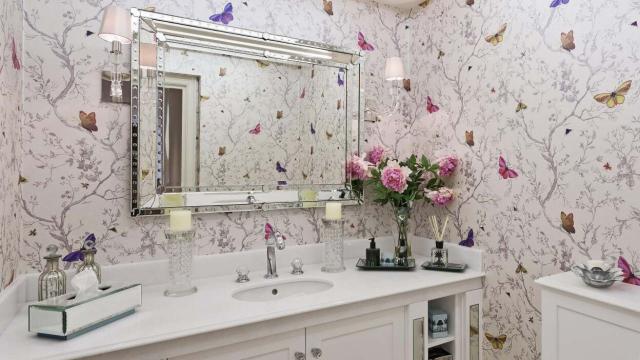Old, outdated wallpaper can be a frustrating challenge to tackle. It takes some doing to get it all off, and if you don’t have the right tools, wallpaper removal can mean endless scraping, shreds of old paper clinging to the walls, and mediocre results in the end. But there is a way to get that old paper off the walls once and for all and make your walls look like new again.
For this project, you’ll need:
- A wallpaper scoring tool
- A drop cloth
- A spray bottle
- Some wallpaper stripper
- A scraping tool
- A sponge
- Some sandpaper
Gloves and a bucket will also come in handy.
What to prepare before removing wallpaper
Pull all your furniture away from the wall and turn off the power to the lights and outlets in the room you’re working on to protect them as well as avoid the danger of shock if the outlet or light circuits get wet. Cover outlets and switches with plastic or tape, and then put down a drop cloth to protect the floor.
Before you start, check what kind of wallpaper you have. If it’s peel-able, you need to peel off the top layer of the paper, and you don’t need to score it before dousing it with stripper. If it’s removable, you can skip all the other steps and just peel it off the wall, using a little bit of the stripper if you have stubborn sticky spots. For peel-and-stick, you’ll have to see if it will come off in larger pieces. If it’s been up for a while, you might need to treat it the way you would treat other types of wallpaper because heat and damage to the surface can make it difficult to peel. If it’s vinyl or paper, follow the steps for removal.
How to score and strip wallpaper
Next, you can score the surface of the wallpaper by running the wallpaper scoring tool over the wall, puncturing the paper to allow the stripper to seep through. Make sure to get as far into the nooks and crannies as you can to avoid leaving paper clinging to the corners of the room, making it hard to remove. If your tool doesn’t reach the corners, you can use a utility knife or even a fork to get in there and make a few punctures in the paper.
Once the surface is scored all over, spray your stripper onto the wall, making sure not to get too much on other nearby surfaces in the process. If you prefer a less harsh method, mixing one part white vinegar with three parts water can work with some types of wallpaper.
The solution should be allowed to soak in for about an hour. To test to see if it’s time to peel, try pulling up a corner. If it comes away easily, you can start removing. If not, wait a few more minutes or add some more stripper if your wallpaper hasn’t been fully soaked. If the stripper is working, you should see the wallpaper start to wrinkle and pull away from the wall in some places.
Once the paste begins to let go, peel the paper away from the wall by hand as much as you can. Use your scraping tool to work on areas where the glue might be a bit thicker. The paper should come off fairly easily now, but if you’re still encountering areas where it’s still firmly stuck, you can douse it again with the stripper and scrape again.
Next, any remnants of the glue or smaller shreds can be scrubbed off with a sponge and some stripper. Using the rough side of the sponge can help get the stickier globs of glue off of the wall. You might need to repeat this part of the process a few times to get all of the glue off the wall.
What to do after removing wallpaper
Last, once the wall is dry, you can use some sandpaper to scrub away any tiny bits of paper or rough patches left behind. You should only do this step if you have walls that are newer than 1978, though. If they’re older, you need to assume there’s lead in the paint and avoid creating dust that can enter your body through your lungs.
Once your walls are smooth, apply a primer to even out the color of the wall and seal it before proceeding to the new wallpaper or paint. Just make sure everything is fully dry before putting a coat of primer on the wall so the paint will dry evenly without streaking.

Leave a Reply
You must be logged in to post a comment.